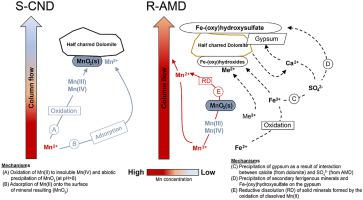Chemosphere ( IF 8.8 ) Pub Date : 2020-06-17 , DOI: 10.1016/j.chemosphere.2020.127424 Bryce Le Bourre 1 , Carmen M Neculita 1 , Lucie Coudert 1 , Eric Rosa 2

|
Efficiency of Mn passive treatment from mine drainage (MD) is limited, in the presence of Fe, because of the wide stability field of dissolved Mn(II) species. Physicochemical and mineralogical characterization, as well as static leaching tests at pH 7 (CTEU-9) of four samples were performed to assess Mn immobilization processes from MD and post-treatment stability of residues. Samples consisted of half-calcined dolomite, from three column reactors that treated Mn in MD. The first residue originated from real acid mine drainage treatment (R-AMD; pH 2.4; 623 mg/L Fe; 22 mg/L Mn), the second from real contaminated neutral drainage (R-CND; pH 6.7; 0.6 mg/L Mn) and the third from synthetic CND (S-CND; pH 6.8; 47 mg/L Mn). A sample of calcite (CAL) was also collected in a field oxic limestone drain that treats AMD (pH 4.1; 10.2 mg/L Fe; 12.4 mg/L Mn) on a closed mine site. Mineralogical analyses showed Mn immobilization in the form of MnOx. In R-AMD residues, Fe and Al concentrations almost doubled relative to half calcined dolomite before MD treatment, while Mn removal was inefficient. In S-CND residues, high concentrations of Mn were immobilized (>6.6 g/kg). The mineralogy of R-AMD residues showed that Fe precipitates coated the dolomite, in the form of Fe-(oxy)hydroxysulfates. Half-calcined dolomite is effective for Mn removal in S-CND, but Fe inhibits Mn treatment in AMD. Metal(loid)s in eluates were below the threshold limits, but the pH of R-CND (11.1) and S-CND (10.5) residues no longer met the discharge criteria (pH 6.0 to 9.5).
中文翻译:

矿山排水的被动处理中残留物中的锰去除过程和地球化学行为。
由于存在溶解的Mn(II)种类,因此存在Fe时,在存在Fe的情况下,矿山排水(MD)进行的Mn被动处理的效率受到限制。进行了四个样品的理化和矿物学表征,以及在pH 7(CTEU-9)下的静态浸出测试,以评估MD的Mn固定化过程和残留物的后处理稳定性。样品由来自三个处理MD中Mn的柱式反应器的半煅烧白云石组成。第一个残留物来自真实的酸性矿山排水处理(R-AMD; pH 2.4; Fe 623 mg / L; Mn 22 mg / L),第二个残留物来自真实污染的中性排水(R-CND; pH 6.7; 0.6 mg / L) Mn)和第三种来自合成CND(S-CND; pH 6.8; 47 mg / L Mn)。方解石(CAL)样品也收集在处理AMD(pH 4.1; 10.2 mg / L Fe; 12。4 mg / L Mn)在一个封闭的矿场上。矿物学分析表明以MnO形式固定了MnX。在R-AMD残留物中,相对于MD处理前半煅烧的白云石,Fe和Al的浓度几乎翻了一番,而Mn的去除效率很低。在S-CND残留物中,固定了高浓度的Mn(> 6.6 g / kg)。R-AMD残留物的矿物学表明,Fe沉淀物以Fe-(氧基)羟基硫酸盐的形式覆盖了白云石。半煅烧白云石可有效去除S-CND中的Mn,但Fe抑制AMD中的Mn处理。洗脱液中的金属(金属)含量低于阈值限值,但R-CND(11.1)和S-CND(10.5)残留物的pH值不再满足排放标准(pH 6.0至9.5)。



























 京公网安备 11010802027423号
京公网安备 11010802027423号